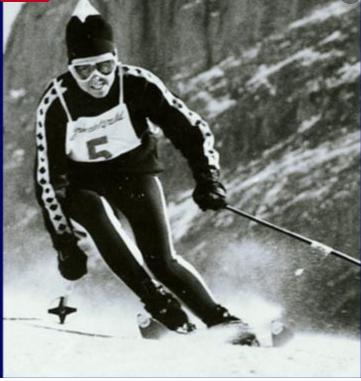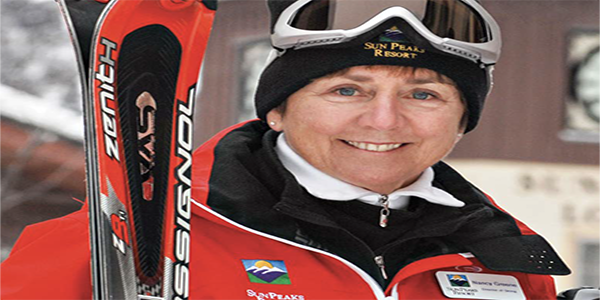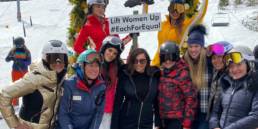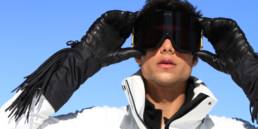Nancy Greene – Tiger Tales
Nancy Greene is a powerful, pixie-haired Canadian skier with a small, sinuous build, quick, dexterous feet, and the spring of a jungle cat. She can pierce an opponent with the sharpness of her gaze and silence a room simply by walking into it. Across Canada, the name Nancy Greene is synonymous, not just with skiing, but with sport, tourism, and senatorial politics… all that at the age of 75. In her youth, in her Olympic prime, in the days she reigned as queen of ski racing, Nancy Greene she was fiercely magnificent.
We meet Senator Nancy Greene Raine on Canada’s Parliament Hill. She’s just charged up the front steps of Centre Block, home of Canada’s House of Commons and its Senate — akin to the U.S. Senate and the House of Representatives tied into one. Trailing behind her: a legion of pre-teen hockey players from small town Quebec. Greene spotted the team milling aimlessly on ‘The Hill’ touring Canada’s capital for the first time; the senator offered to “show them around”. Greene and her wide-eyed entourage advanced on Parliament’s front door. Security guards parted hastily to let them past — Greene is known, after all. She’s not just a politician, she’s a Canadian legend.
If these kids weren’t familiar with the identity of this sprightly woman with the loud-speaker voice and the zeal of a brigade leader, their parents would be. Fame has tracked Nancy Greene through decades. She snatched world attention by winning skiing’s inaugural 1967 World Cup overall title, an act that broke the sport’s European domination. The image of Greene hoisting skiing’s first-ever Crystal Globe alongside France’s Jean-Claude Killy is imprinted on the minds of Canadian and international ski fans. She won Gold and Silver at the 1968 Olympic Winter Games in Grenoble, plus a second World Cup overall title — a feat unmatched by any female skier in the 20th century. In total, through ’67-’68, Greene scored a breathless 13 World Cup victories.
There’s more. Like the U.S.-based Buddy Werner League, Canada’s Nancy Greene League for junior racers flourished in the 1970s. Nancy and her husband, formers ski coach Al Raine, helped place Whistler on the map in the 1980s. They did the same for B.C.’s Sun Peaks Resort in the ‘90s. In 2000, she was voted Canada’s Female Athlete of the 20th Century. She lit the Olympic cauldron to open the Vancouver Games in 2010 in the company of Wayne Gretzky. In the last decade, Greene’s prowess led her all the way to the Canadian Senate. It could be said Greene’s prolonged success has everything to do with a skill skiers covet: good balance. It’s a thing she learned early, as a child in Rossland, B.C., a small ski town tucked into the Monashees, just north of the U.S. border. Greene, one of six children, learned to ski at age three by following her mother, who led her brood down Red Mountain’s rough-hewn slopes like a hen guiding ducklings through danger. A disabled arm, the result of a childhood injury, meant her mother eschewed traditional styles of skiing. “In those days ski technique was all about turning
the upper body,” Nancy explains. “Because of her disability, my mom couldn’t turn her upper body so she just stood on her skis, balanced, and turned her feet. I learned to ski by watching her. I learned to ski perfectly balanced.”
 That balance served Greene well. When the Canadian Junior Championships came to Rossland in 1958 Nancy, then 14, wasn’t on the roster, but she was in perfect spot. Red’s fiendish downhill — steep, brutal, unrelenting — was behaving like a monster, chewing up and spitting out young racers. Says Greene: “Everyone was crashing.” The Canuck team was so decimated, Nancy was thrown in as a last-minute entry. “They came to me and said, ‘We need you to race, there’s nobody left!’ Next morning I side slipped the course but I already knew where it went. I knew what to do, so I did it.” Her older sister Elizabeth won that downhill and Nancy finished second.
That balance served Greene well. When the Canadian Junior Championships came to Rossland in 1958 Nancy, then 14, wasn’t on the roster, but she was in perfect spot. Red’s fiendish downhill — steep, brutal, unrelenting — was behaving like a monster, chewing up and spitting out young racers. Says Greene: “Everyone was crashing.” The Canuck team was so decimated, Nancy was thrown in as a last-minute entry. “They came to me and said, ‘We need you to race, there’s nobody left!’ Next morning I side slipped the course but I already knew where it went. I knew what to do, so I did it.” Her older sister Elizabeth won that downhill and Nancy finished second.
The following day Greene placed third in the slalom, even though, as she danced nimbly through the gates, she wiped out twice. “I was on my way,” she says, “from that moment.” Back on Canada’s Parliament Hill, Senator Greene Raine has guided her guests through a maze of impressive Gothic arches — a path Canada’s leaders have walked for a century next to foreign monarchs and presidents. She pointed out bullet marks on the wall, unsettling reminders of the 2014 terrorist attack inside Centre Block as Greene sat nearby in a caucus meeting with Canada’s Prime Minister.
Pointedly, the bullet holes are left out of conventional tours, but Nancy Greene isn’t interested in convention. In her career as a ski racer, she was known for rubbing against the grain, taking new lines, and breaking down barriers to win at any cost, much like Lindsey Vonn or Bode Miller.
Her approach was so fierce, her coach, Verne Anderson, would shout “Go get ‘em, Tiger!”… and she would. In her scrappy climb toward World Cup and Olympic dominance, she suffered many a crash, including a body-slammer in Portillo, Chile, during the 1966 Alpine World Skiing Championships’downhill. Greene hit the roll over a road tunnel too fast, flew into the air, and smacked into an ice wall. “I was sore all over and I still had giant slalom to race the next day. One of my hands was bruised so I got a shot in my knuckles. Turned out I also had a broken tailbone, but it only hurt to sit down and stand up so I kept going.” Greene frowns. “The next day I came fourth.”
The following 1967 season — the first for the FIS World Cup circuit — Greene’s battle against rival Marielle Goitschel of France was just as feisty. Greene spent the off-season training like a fiend under the eye of an expert in military fitness. Better yet, Rossignol sent their star skier a revolutionary set of skis called Stratos and Greene was loving them.
In the early season on slopes in Germany and Switzerland, the 23-year-old blasted out of starting gates like she’d been lit by rockets, winning races by massive gaps and racking up points toward overall victory. By the end of the season however, Goitschel had caught up, and the sure slope
‘beneath Tiger’s skis began to shake. By the season’s closing races in March at Jackson Hole, Goitschel and Greene were helmet to helmet. It came down to their second run in the slalom to decide the first ever female FIS World Cup overall winner. “Greene took every risk,” writes John Fry in The Story of Modern Skiing, “twisting through the flags, her edges rasping on the icy snow. When she flashed through the finish in a low crouch, her time was 7/100ths of a second faster than Goitschel’s.” In that single moment, Greene surpassed the Europeans and earned a top spot in ski racing history.
 Again, Tiger’s Olympic GS Gold in 1968 at Grenoble was gritty, yet for different reasons. Greene, the favorite, placed a devastating 10th place in the Olympic downhill. With tears of frustration fogging her goggles, she got back at it that very afternoon, driving herself through a slalom training course time and again to gain back confidence. The following day she rose from the ashes to place second in the slalom. Then, with the guts and grind Greene is known for, she trounced her competition in the Olympic giant slalom, beating Annie Famose in her native France by 2.65 seconds, a jaw-droppingly decisive margin. Her time didn’t show on the board immediately and rumors swirled that Greene skied so fast she broke Omega’s timing mechanism. Not true. According to Greene, the delay in revealing her result was necessary as the astounding time was verified. “Of course, my heart almost stopped!” Greene said later. “People often ask what I felt like in the finish area and I tell them my biggest emotion was relief.” Post tour of Parliament Hill, Senator Greene Raine is seated at a broad, well polished table in her corner senatorial office, Canada’s iconic Peace Tower rising like an imposing obelisk just outside the window. Tiger’s stature is compact and lithe. Despite a recent cancer scare, her movements are snappy and athletic. She wears a shirt as white and as crisp as snow, and her eyes dance as she talks about her career’s third act: the Senate. Not surprisingly, Greene’s focus has been on promoting fitness and, yes, balance. She’s heading the Child Health Protection Act, proposing legislation to prohibit advertising of unhealthy foods to youth. She’s known among senators and parliamentarians for organizing weekly meetups to exercise — run, swim, ski — on The Hill. And Greene helped establish the National Health and Fitness Foundation. “Our goal,” she says, “is to make Canada the fittest nation in the world.”
Again, Tiger’s Olympic GS Gold in 1968 at Grenoble was gritty, yet for different reasons. Greene, the favorite, placed a devastating 10th place in the Olympic downhill. With tears of frustration fogging her goggles, she got back at it that very afternoon, driving herself through a slalom training course time and again to gain back confidence. The following day she rose from the ashes to place second in the slalom. Then, with the guts and grind Greene is known for, she trounced her competition in the Olympic giant slalom, beating Annie Famose in her native France by 2.65 seconds, a jaw-droppingly decisive margin. Her time didn’t show on the board immediately and rumors swirled that Greene skied so fast she broke Omega’s timing mechanism. Not true. According to Greene, the delay in revealing her result was necessary as the astounding time was verified. “Of course, my heart almost stopped!” Greene said later. “People often ask what I felt like in the finish area and I tell them my biggest emotion was relief.” Post tour of Parliament Hill, Senator Greene Raine is seated at a broad, well polished table in her corner senatorial office, Canada’s iconic Peace Tower rising like an imposing obelisk just outside the window. Tiger’s stature is compact and lithe. Despite a recent cancer scare, her movements are snappy and athletic. She wears a shirt as white and as crisp as snow, and her eyes dance as she talks about her career’s third act: the Senate. Not surprisingly, Greene’s focus has been on promoting fitness and, yes, balance. She’s heading the Child Health Protection Act, proposing legislation to prohibit advertising of unhealthy foods to youth. She’s known among senators and parliamentarians for organizing weekly meetups to exercise — run, swim, ski — on The Hill. And Greene helped establish the National Health and Fitness Foundation. “Our goal,” she says, “is to make Canada the fittest nation in the world.”
Now, at age 75, Greene is faced with mandatory Senate retirement. She’s headed back to Sun Peaks, where she’s still Director of Skiing. She’s re-joining husband Al Raine, a hotel owner and ski resort developer who’s now the local mayor. Say “Al and Nancy” to any soul in the Canadian ski industry and they’ll tell you a story of the power couple’s formidability. Al and Nancy were at the forefront of Whistler’s rise on the world ski stage, helping map out its village. Their move to Sun Peaks lit the obscure ski resort with the wattage of a mega spotlight. In 2010, their endorsements helped send the Olympic Winter Games back to Canada.
The interview is done. Greene has shuttered her ample office and is charging back across The Hill at a pace that’s hard to match for a soul half her age. With Canada’s Parliament a striking backdrop, she’s asked to name a favorite aspect of the senate life she’s poised to leave behind. She thinks about it, stumbling for words — unusual for a talker like Tiger. “I can’t” she says, finally. “It’s like asking the name of my favorite ski run. They’re all interesting.”
Greene disappears into a crowd of tourists. She’s gone, but not for long. She pops up moments later with another group of kids she has found wandering aimlessly on The Hill. With a Tiger’s grin, she offers to show them around…




